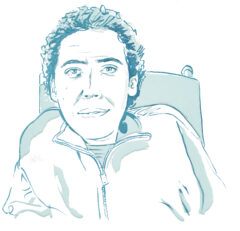This case study features in the Schmidt Science Fellows Annual Report 2019-2020.
 Dr. Ahmad Omar is a 2019 Schmidt Science Fellow. Completing his PhD at the California Institute of Technology (Caltech), Ahmad used theoretical and computational tools to develop a more complete molecular description of the mechanical properties of hydrogels. Ahmad deferred a faculty job offer at UC Berkeley to pursue his Schmidt Science Fellows Placement, also at UC Berkeley. During his Fellowship Year, working with Dr. Phillip Geissler, he pivoted from soft matter engineering to explore the fields of nonequilibrium statistical physics and stochastic thermodynamics.
Dr. Ahmad Omar is a 2019 Schmidt Science Fellow. Completing his PhD at the California Institute of Technology (Caltech), Ahmad used theoretical and computational tools to develop a more complete molecular description of the mechanical properties of hydrogels. Ahmad deferred a faculty job offer at UC Berkeley to pursue his Schmidt Science Fellows Placement, also at UC Berkeley. During his Fellowship Year, working with Dr. Phillip Geissler, he pivoted from soft matter engineering to explore the fields of nonequilibrium statistical physics and stochastic thermodynamics.
Tell us about your background and PhD research
Throughout my PhD in chemical engineering, I was motivated to find a topic where I could use theory and computation to provide insight into materials that might improve the human condition. That led me to working on the fundamental and appealing properties of materials called hydrogels, polymeric materials that can be used as drug delivery vectors and for wound healing agents.
A hydrogel is mainly water. They are very, very dilute so they are minimally invasive. At the same time, we can provide structure and support with different polymers to embed drugs in the hydrogel.
I’ll use the ideas that I was able to develop throughout my Fellowship Year in nonequilibrium statistical mechanics to build a research group…
How has Schmidt Science Fellows supported you to develop your science?
Analytically and theoretically, I previously focused on systems that were in thermodynamic equilibrium: that means there is no net current (such as energy or mass) flowing into or out of the system. When those thermodynamic equilibrium conditions are met, you can actually do a lot of things because we know the exact distribution of states that molecules occupy.
An outstanding challenge is when you have a current in your system, such as a gel subject to external deformation, so it is no longer in equilibrium. My frustration towards the end of my PhD with being unable to theoretically describe a huge class of problems led me to pivot to pursue more theoretical research in the field of non-equilibrium statistical mechanics.
What have you valued most from your time so far as a Schmidt Science Fellow?
The support and mentorship that we’ve received from the Academic Council has been valuable. Keith Burnett has been able to advise me on science from his own experience having worked on condensed matter physics for much of his career.
John Boothroyd held sessions on how to manage people, how to manage a group, how to write grants, and other vital skills. Without this Fellowship, you’re just expected to figure it out. It’s nice having these additional primers, it just gets you thinking about things ahead of you.
How has Program support helped you?
There was a lack of wheelchair-accessible housing around Berkeley during the first months of my Placement. The Program provided me with the resources to make frequent trips to Berkeley from my home near Caltech during those early months. That was super valuable and very nice of them to recognise that I was in a difficult circumstance, and make things work.
What plans do you have for 2021 and beyond?
This summer, I’ll transition to a faculty position in the UC Berkeley Department of Materials Science and Engineering. I’ll use the ideas that I was able to develop throughout my Fellowship Year in nonequilibrium statistical mechanics to build a research group that really understands all aspects of the materials that we’re interested in.
I strongly believe that if you have a better understanding of the connection between microscopic molecular variables and the macroscopic properties, we can engineer better next-generation materials in all contexts. It’s how we make better consumer products; it’s how we make better biomaterials; it’s how we make new materials for energy collection and storage.